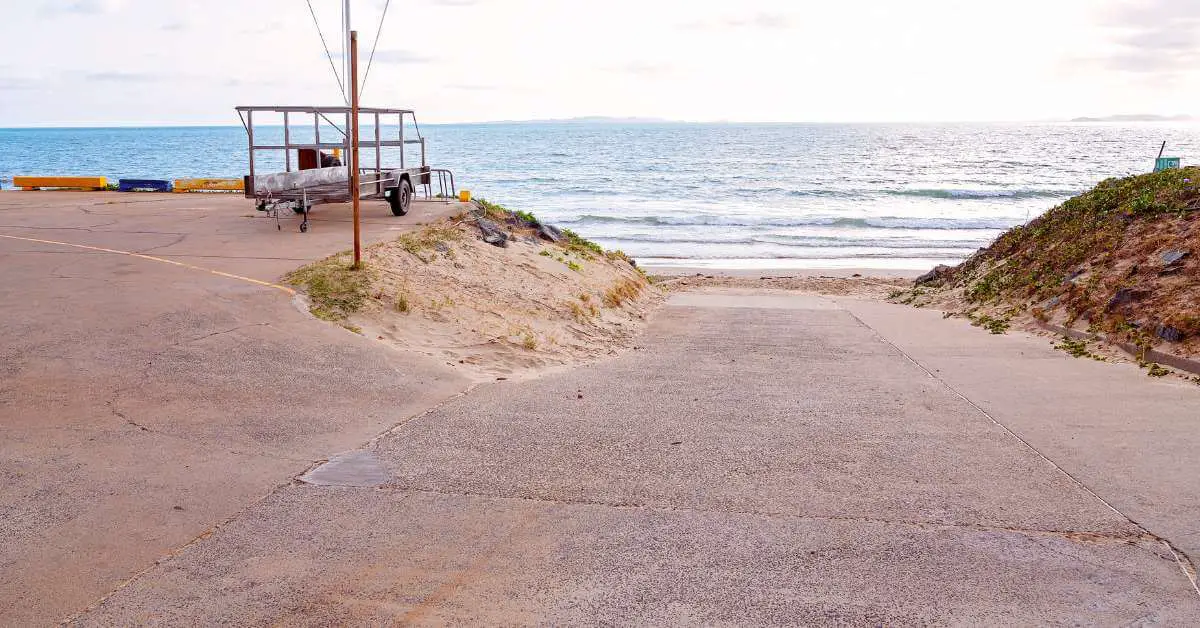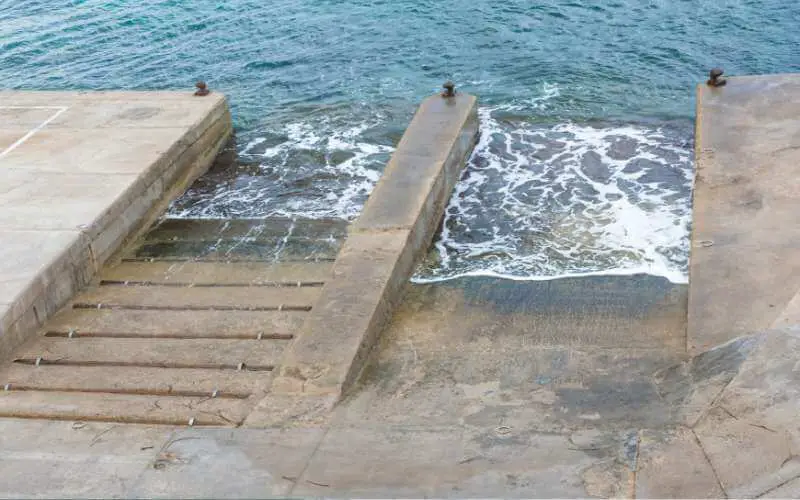Boat ramps are an essential link between land and water for anyone who enjoys boating. Whether you own a boat or rent one occasionally, knowing how and where to access the water safely is crucial. But have you ever wondered about the different types and which factors determine their location and design?
This article aims to answer these questions and provide key insights into the fascinating world of boat ramps. So fasten your lifejacket, and let’s dive in!
What are Boat Ramps?
A boat ramp, also known as a boat launch or boat slip, is a structure designed to facilitate the launching and retrieval of boats from bodies of water. It provides a smooth transition for boats, allowing them to move from a trailer or dry land into the water and vice versa.
They are typically constructed with a sloping surface that gradually leads into the water. This gradual slope allows boats to be safely launched or retrieved using trailers and tow vehicles. The surface of the ramp is often made of concrete or another durable material to withstand the weight and impact of boats.
Boat ramps are essential for boaters, as they provide an easy and convenient way to access the water. They can be found in various locations, such as marinas, public parks, and waterfront areas, catering to recreational and commercial boating activities.
In addition to launching and retrieving boats, boat ramps may include floating docks, boarding piers, and parking areas for trailers and vehicles.
The Importance of Boat Ramps
Boat ramps are important to boating enthusiasts and the overall boating community. They serve as crucial access points between land and water, providing benefits and facilitating boating activities. Let’s explore some key reasons why boat ramps are essential:
1. Launching and Retrieving Boats
Boat ramps are designed to allow boats to be safely launched into the water and retrieved back onto land. By providing a smooth transition between the trailer and the water, ramps enable boaters to easily and efficiently get their boats in and out of the water.
2. Convenience and Accessibility
They ensure convenient access to water bodies, making it easier for boaters to enjoy their recreational activities. They allow boaters to transport their boats on trailers and launch them at their desired location rather than relying solely on marinas or designated boat yards.
3. Safety
Boat ramps are designed with safety considerations in mind. The gradual slope of the ramp minimizes the risk of damage to boats by keeping the trailer submerged until the boat is ready for launch. Additionally, many boat ramps incorporate non-slip surfaces, lighting, and signage to enhance safety during the launching and retrieval.
4. Supporting Boating Industry
Boat ramps play a vital role in supporting the boating industry. They provide access to water bodies for recreational boaters, fishing enthusiasts, and water sports enthusiasts. By offering convenient access to the water, boat ramps contribute to the boating industry’s overall growth and sustainability, including boat manufacturers, marine retailers, and service providers.
5. Emergency Response
In situations requiring immediate action, such as search and rescue operations or water-based emergencies, they serve as crucial entry and exit points for emergency response teams. These ramps enable swift water access, allowing quicker response times and potentially saving lives.
6. Environmental Protection
Properly designed boat ramps consider environmental factors such as erosion control and water quality. Features such as erosion control measures, sediment traps, and filtration systems can be incorporated into boat ramp design to minimize the impact on the surrounding environment and protect water quality.
7. Social and Recreational Benefits
Boat ramps allow people to engage in recreational activities, connect with nature, and spend quality time with family and friends. They facilitate various boating activities, such as fishing, sailing, water sports, and leisurely cruises, contributing to individuals’ and communities’ overall well-being and enjoyment.
Types of Boat Ramps
1. Concrete Boat Ramps
Concrete boat ramps are widely used and offer durability and strength. They provide a smooth surface for launching and retrieving boats. The advantages of concrete boat ramps include their ability to withstand heavy usage and low maintenance requirements. They also provide good traction for vehicles and trailers. However, the initial construction cost of a concrete boat ramp can be high.
2. Gravel Boat Ramps
Gravel boat ramps are relatively inexpensive and commonly found in smaller or less developed areas. They are easy to maintain and can offer good traction for vehicles. However, gravel ramps may be susceptible to erosion, especially in areas with high water flow or heavy boat traffic.
3. Paved Boat Ramps
Paved boat ramps are similar to concrete ramps but may use asphalt or other pavement material. They offer a smooth surface and good traction for launching and landing boats. Paved ramps are generally more cost-effective compared to concrete ramps. However, they may require more frequent maintenance and can be susceptible to cracking or damage over time.
4. Natural Boat Ramps
Natural boat ramps are undeveloped areas where boats can be launched directly from the shoreline or a gently sloping beach. These ramps are often found in remote or less populated areas. The advantages of natural ramps are their simplicity and low cost. However, they may not provide the same level of convenience or accessibility as constructed ramps. They may also be affected by changing water levels, vegetation, and natural obstacles.
What to Consider When Designing Boat Ramps
Slope
The slope of the boat ramp is essential to ensure safe and efficient boat launching and retrieval. The slope should be steep enough to allow boats to enter and exit the water without the trailer touching the water but not so sharp that the towing vehicle is at risk of accidentally sliding into the water.
Depth
Consider the water depth required for launching and retrieving boats. The boat ramp should adequately extend into the water to allow easy access to deeper water.
Traction
Sufficient traction on the boat ramp surface is crucial for vehicles and trailers. Concrete, gravel, or paved surfaces with textured or non-slip materials can enhance traction and help prevent sliding or accidents.
Accessibility
Ensure the boat ramp is easily accessible for vehicles, trailers, and boaters. Consider road access, parking space, turning radius, and proximity to other boat ramps.
Erosion Control
Implement measures to prevent erosion around the boat ramp, particularly in areas with high water flow or heavy boat traffic. Proper grading, installation of erosion control structures, and vegetation management can help mitigate erosion risks.
Environmental Impact
Take into account the potential environmental impact of the boat ramp design. Consider factors such as water quality, habitat preservation, and adherence to local regulations and permits.
Maintenance
Consider the long-term maintenance requirements of the boat ramp design. Choose materials and construction methods that are durable, easy to maintain, and cost-effective.
Environmental Impact of Boat Ramps and Mitigation
The construction of boat ramps can have various environmental impacts that must be considered and mitigated. These impacts may include:
Sedimentation
The construction process can result in the disturbance of soil and sediment, increasing the potential for erosion and sediment runoff. This sediment can enter nearby water bodies, affecting water quality and aquatic habitats.
Habitat disturbance
Construction activities may disrupt or destroy habitats such as wetlands, vegetation, and wildlife habitats in and around the boat ramp area. This disturbance can impact local ecosystems and biodiversity.
Water pollution
The use of construction materials and machinery can lead to water pollution. Runoff from construction sites may contain pollutants like sediment, fuel, oils, and chemicals, which can degrade water quality and harm aquatic life.
Stormwater runoff
The increased impervious surfaces associated with boat ramp construction can lead to increased stormwater runoff. This runoff can carry pollutants and cause changes in water flow patterns, potentially affecting downstream areas.
Boat Ramps Maintenance and Management
Boat ramps are managed and maintained through various activities to ensure their functionality and safety. Here are some common practices:
Regular inspection
Boat ramps should be regularly inspected to identify any maintenance or repair needs. This includes checking for cracks, erosion, loose bolts, and other signs of wear and tear.
Cleaning and debris removal
Boat ramps should be kept clean and free of debris, such as leaves, trash, and sediment. Regular cleaning helps maintain proper drainage and prevents slip hazards.
Structural maintenance
Any necessary repairs to the ramp structure, such as fixing cracks, replacing broken boards, or repairing handrails, should be conducted to ensure the ramp’s integrity.
Dredging and sediment removal
Over time, sediment can accumulate near boat ramps, reducing water depth and hindering boat access. Dredging or sediment removal may be necessary periodically to maintain sufficient water depth.
Vegetation management
Vegetation around the boat ramp area should be managed, ensuring it does not obstruct access or impede visibility. Regular trimming or removing vegetation can help maintain clear sightlines and adequate space for launching and retrieving boats.
Signage and markings
Clear signage should be installed to provide important information, such as speed limits, parking regulations, and safety instructions. Additionally, visible markings on the ramp, such as depth markers or boundary lines, can assist boaters in safely navigating the area.
Stormwater management
Implementing stormwater management practices is crucial to prevent erosion and reduce the pollution runoff from the ramp area. This may include using retention ponds, vegetative buffers, or stormwater control structures.
Safety Measures at Boat Ramps
Please, it is important to follow all posted instructions and regulations to ensure the safety of both boaters and other users. Also, boaters should make sure they know proper boating etiquette and respect other ramp users to minimize conflicts and accidents.
Safety measures put in place at boat ramps include:
1. Clear signage and markings: Boat ramps should have visible signage and markings that provide important information such as speed limits, parking regulations, and safety instructions.
2. Designated waiting areas: Boat ramps may have designated waiting areas where boaters can prepare their vessels before launching, reducing congestion and potential accidents.
3. Proper lighting: Adequate lighting should be in place to ensure visibility and safety during day and night operations at the boat ramp.
4. Safe access: Boat ramps should have safe access points for boaters to enter and exit their vessels. This can include stable gangways, stairs, handrails, and non-slip surfaces.
5. Vessel preparation area: Boat ramps should provide a designated area where boaters can properly prepare their vessels before launching, such as installing drain plugs, removing transom tie-downs, and loading gear.
6. On-site facilities: Having on-site facilities such as restrooms, rubbish bins, and proper waste disposal can contribute to a safer and more convenient boating experience.
7. Clear communication: Communication systems, such as cell phones or marine radios, can enable boaters to coordinate with friends or family bringing the trailer to the ramp, ensuring a smooth and safe launching process.
Future Developments in Boat Ramp Design
Future developments in boat ramp design focus on improving functionality, accessibility, and environmental sustainability. Here are some potential advancements:
1. Innovative Materials: Using new materials, such as durable composite materials or eco-friendly alternatives, may enhance its longevity and sustainability.
2. Modular Design: Modular boat ramps, consisting of precast sections that can be easily assembled or disassembled, offer flexibility and adaptability for changing water levels and shoreline conditions.
3. Improved Accessibility: Incorporating universal design principles, including accessible ramps, handrails, and signage, ensures that individuals with disabilities or mobility challenges can use boat ramps.
4. Advanced Drainage Systems: Developing efficient drainage systems that minimize sediment runoff and prevent pollution can help maintain water quality.
5. Technology Integration: Integrating technology, such as automated launching or real-time monitoring systems, can enhance efficiency and safety.
6. Environmental Considerations: Implementing environmentally friendly features like floating boat docks or vegetation buffers can help protect sensitive ecosystems and prevent shoreline erosion.
7. Safety Enhancements: Additional safety features like improved lighting, better boat traffic management systems, and video monitoring can enhance safety.
Conclusion
Boat ramps play a crucial role in facilitating safe and convenient access to water bodies for boaters. Its design and management should prioritize safety, functionality, and environmental sustainability.
Incorporating clear signage, designated waiting areas, proper lighting, safe access points, and on-site facilities can enhance the boating experience while minimizing accidents and conflicts.
As we look to the future, advancements in boat ramp design, including innovative materials, modular structures, improved accessibility, advanced drainage systems, technology integration, environmental considerations, and enhanced safety features, hold promising potential for further improving its efficiency, accessibility, and environmental impact.
Reference









